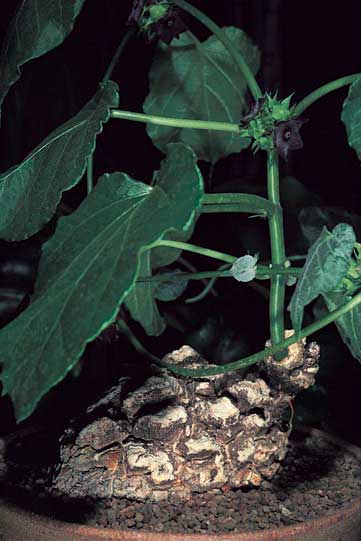Sometimes grown under the nomen nudum (a name not validly published) of Gonolobus cyclophyllus, this unusual Mexican milkweed produces a caudex resembling that of a diminutive Dioscorea macrostachya (also from Mexico) or D. elephantipes (from S. Africa) covered with angular corky tubercles. But the vining growth that emerges looks more like a pubescent green-bean plant. The flowers, however, are bizarre and beautiful, typical of the Asclepiadaceae. They resemble a bat sea-star with five short corolla lobes. The corolla surface is pubescent and usually a deep maroon, though “albino” green forms also occur (3rd. image). The reproductive structures at the center of the flower are also its aesthetic focus, meriting a closer look with a lens. They appear as a white-bordered red star atop a dark maroon cage-like corona. HBG 86543, grown from self-pollinated seed from a plant collected Aug. 1983 by the late Steve Southwell, with Woody Minnich, 1.5 mi. W of Tolimán (15 mi. E of Huajuapan), Querétaro, Mexico. In Aug., 2001, when I last spoke with Steve, he described the plants in habitat as forming caudexes the size of coffee mugs. The plants seemed to have fleshier leaves (1/16" thick) than when grown in cultivation and were in flower at the time. They were growing in heavy pine-oak duff in the shade of rocks and fallen logs in association with Mammillaria tolimanensis and M. aff. albilanata, the latter with yellow central spines. Matelea cyclophylla has been discussed and illustrated elsewhere in the Cactus and Succulent Journal in recent (as of 2002) years. Mostul and Cházaro described their search for the plant in habitat (vol. 70: 301-303, 1998). Duke Benadom illustrates the parent of our offering in his Superb Succulents column in the Mar. - Apr. 2001 issue. $6.

Published in the Cactus and Succulent Journal, Vol. 74 (2), March - April, 2002


